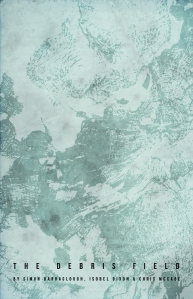‘The Debris Field’ by Simon Barraclough, Isobel Dixon and Chris McCabe
-Reviewed by David Clarke–
The Atlantic liner Titanic, which sank on its maiden voyage in April 1912 with the loss of more than 1,500 people, has achieved a remarkable status in western culture. It has become a persistent moral metaphor, serving to illustrate everything from the hubris of humanity (as in Thomas Hardy’s ‘The Convergence of the Twain’), to the failings of the class system (as in Roy Baker’s still harrowing 1958 film A Night to Remember) and the dangers of a misplaced confidence in progress (as in Hans Magnus Enzenberger’s poem sequence The Sinking of the Titanic of 1978). In the Second World War, the story even served Joseph Goebbels as a symbol of the evils of British capitalism, the theme of a 1943 film drama he commissioned on the disaster (see The Titanic in Myth and Memory: Representations in Visual and Literary Culture for more on this). Slavoj Žižek has aptly described the Titanic as a symptom of modern culture in the psychoanalytic sense, a ‘knot of meanings’ occupying a space in our collective imagination that somehow pre-existed the actual disaster itself: as Žižek points out, one popular novel from 1898 had already described the sinking of a ship called Titan in uncannily similar circumstances.
It is this ‘knot of meanings’ that The Debris Field sets out to explore. Here the Titanic is described as a ‘double ship’, ghosted by its own myth. The pamphlet results from a multimedia project to mark the centenary of the Titanic that poets Simon Barraclough, Isobel Dixon and Chris McCabe developed in collaboration with filmmaker Jack Wake-Walker and composer Oli Barrett. The complete film is scheduled for release on DVD, but the publication of the pamphlet stakes a claim for the words to have an independent existence beyond the original project. In a recent article, Isobel Dixon relates how the poets’ ‘aim was to be evocative rather than simply narrative, to draw on striking nuggets of fact, but also ideas of labour and ambition, poverty and wealth, bravery and loss, brotherhood and love and nature’s power.’ This non-narrative approach is achieved in a fragmentary text that, while roughly following the ship’s progress from construction to destruction, does not seek to describe events in detail, focusing instead on the conjuring up of particular moments and images.
This is an exploration not just of the physical debris of the ship, but also of the symbolic field that has survived it and continues to grow. The design chosen by Sidekick Books also evokes this process: printed on blue paper, each page with its own creases and watermarks as a background to the text, the look of the pamphlet suggests this sifting through the debris in a deep, dark place. But the debris field of the ship is also a dreamspace, as the poets suggest when they begin by performing an act of hypnotism on their audience in the opening pages, counting down to ten as we find ourselves going ‘deeper and deeper’.
What we find in these depths is stylistically heterogeneous, but certainly contains some wonderfully effective poetic fragments that, taken together, capture a whole panorama of characters and incidents in precise, controlled language. These carefully observed and economically evoked pieces of the past seem to flare up out of the darkness of the ocean fleetingly before disappearing again. The poets have chosen not to identify their individual contributions, but the impression is in any case that of a compendium of more than their own three voices. There are direct quotations from witnesses and montages of contemporary popular songs, short rhyming lyrics, as well as examples of conceptual and concrete writing. The tone shifts between ironic depictions of the opulent life on board (for example in the sections ‘The bugler calls’ or ‘Rub-a-dub-dub, the Captain’s tub’) and more elegiac elements. There are also attempts to establish contemporary resonances, for instance in a piece of prose poetry that combines the words of a young girl who survived the disaster with fragments of text about contemporary capitalism and the effects of water shortages for children in the Third World.
Once the pamphlet has reached the point in the story where the ship strikes the iceberg, however, it is the elegiac tone that comes to dominate. The penultimate section is a slightly longer sequence of verses giving voice to the ship’s dead, highlighting how even the recovered corpses were treated differently according to their social status. However, this social message is finally held in balance with a tendency to see the sinking of the ship as more of a universal metaphor for human mortality: ‘From debris we come / and to debris we go.’
The Debris Field is convincingly executed as a meditation on historical events, and innovative in terms of its formal hybridity. However, while it was enjoyable as a reading experience, I did not find it entirely satisfying. The subject of the Titanic is difficult to approach from a new angle. As a ‘knot of meanings’ (to return Žižek’s phrase) it has been understood in so many different ways, many of which are explored in this pamphlet, that it has become culturally over-determined. The fragmentary nature of this text is perhaps a recognition of the impossibility of telling a new story about the Titanic. Rather, in a thoroughly post-modern move, the poets can only sift through the meanings that are already floating around in the culture. As a consequence, and despite the undoubted quality of much of the poetry itself, I could not say that the effect of reading the pamphlet as a whole was to make me feel or think differently about the Titanic or about any of the significance that we have been attaching to it now for over a century.




